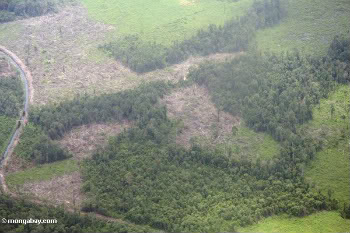|
|
By the end of the century nations in Southeast Asia will face debilitating economic loss due to global warming, according to a new study from the Asian Development Bank. Analyzing Indonesia, Philippines, Thailand, and Vietnam the study found that they could suffer an annual loss of 6.7 percent ($230 billion dollars) in combined gross domestic product by 2100, more than double the global average which is estimated at a loss of 2.6 percent.
Rice yields, the agricultural staple of Southeast Asia, will be hit particularly hard with the region suffering a 50 percent decline in rice yields by 2100. The Philippines would see the worst decline with a 75 percent loss in its rice fields.
 Slash-and-burn agriculture in Indonesia. Photo by: Rhett A. Butler. |
The study states that Southeast Asia is particularly susceptible to extreme weather, higher temperatures, and rising sea levels due to it extensive coastlines, economies dependent on agriculture, and rampant large-scale deforestation. Annual mean temperatures are expected to rise an average of 4.8 degrees Celsius in the region by century’s end, if greenhouse gas emissions are not regulated.
Assistant chief economist at ADB, Juzhong Zhuang told Reuters that these nations “need regional-level activity and it is needed now. If the action is delayed then south-east Asia will suffer much more than most other regions of the world. What’s needed is better government policy, better co-ordination between agencies and between central and local government, and better research by all countries.”
Most of Southeast Asia’s carbon emissions are due to deforestation instead of the burning of fossil fuels. Eighty percent of Indonesia’s emissions, for example, are due to deforestation and conversion of peat lands, largely for palm oil plantations. Worldwide deforestation accounts for nearly 20 percent of emissions.
Related articles
Cutting greenhouse gases now would save world from worst global warming scenarios
(04/14/2009) If nations worked together to produce large cuts in greenhouse gases, the world would be saved from global warming’s worst-case-scenarios, according to a new study from the National Center for Atmospheric Research (NCAR). The study found that, although temperatures are set to rise this century, cutting greenhouse gases by 70 percent the globe could avoid the most dangerous aspects of climate change, including a drastic rise in sea level, melting of the Arctic sea ice, and large-scale changes in precipitation. In addition such cuts would eventually allow the climate to stabilize by the end of the century rather than a continuous rise in temperatures.
Global warming will hit corn yields, costing US over a billion dollars annually
(04/10/2009) Corn is the staple crop of the US. Its annual yield is more than twice that of any other American crop, covering an astounding 125,000 square miles. However, this behemoth crop is currently threatened. A new analysis by Environment America, shows that lower yields of corn due to global warming will cost farmers 1.4 billion every year.
CO2 levels rise to a new record
(02/17/2009) Atmospheric carbon dioxide concentrations climbed 2.28 parts-per-million (ppm) in 2008 to the highest level in at least 650,000 years — and possibly 20 million years — reports NOAA.